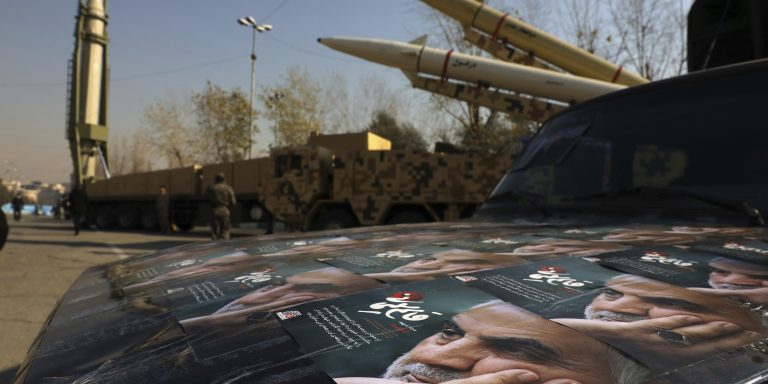
Iran-backed attacks on U.S. forces and allies in early January represent Iran’s ongoing effort to avenge the killing of Islamic Revolutionary Guard Corps – Qods Force commander Qasem Soleimani two years ago.
Strategically, Iran seeks to show that it can threaten the United States or its allies anywhere in the region, and at any time.
Iranian leaders calculate that the attacks will cause the United States to further reduce its military footprint in the region and will intimidate regional adversaries.
The attacks are unlikely to derail the ongoing talks to restore U.S. and Iranian compliance with the 2015 multilateral Iran nuclear deal unless there is a significant loss of U.S. life.
In the days surrounding the second anniversary of the January 3, 2020, strike that killed Islamic Revolutionary Guard Corps – Qods Force (IRGC-QF) commander Qassem Soleimani, a revered figure in Iran, Iran’s regional allies ramped up attacks on U.S. forces in Iraq and Syria and on U.S. allies. In recent weeks, rockets rained down on the “Green Village” base in eastern Syria, which houses some of the approximately 900 U.S. troops deployed in Syria. During January 2-4, armed drones sought to strike U.S. forces at the Camp Victory facility near Baghdad International Airport—the nerve center for the 2,500 U.S. forces in Iraq—as well the Ain al-Assad airbase in western Iraq. The latter was the site of Iran’s January 2020 ballistic missile strike that retaliated for the Soleimani killing, which caused traumatic brain injuries to over 100 U.S. military personnel. All of the attacks were thwarted by U.S. defense systems and caused no U.S. casualties, but there was damage to some of the facilities. In Syria, U.S. forces at Green Village launched ground artillery to head off what they suspected was an imminent follow-on attack. Asked about the responsibility for the attacks, Pentagon press secretary John Kirby clearly implied that the attacks were sponsored by Iran, stating on January 5: “[These] sorts of attacks are very much typical of what we have been seeing in recent months, even years, by militia groups that are supported by Iran. And so that remains our working level assumption, that these are in fact Iran-backed groups.”
Separately, on January 3, the Iran-backed Zaidi Shia “Houthis,” based in the Red Sea port of Hodeida, Yemen, seized the United Arab Emirates-flagged Rwabee ship, claiming it contained military equipment. Saudi Arabia, the UAE’s coalition partner fighting the Houthis in Yemen, claimed that the ship was in international waters and carried only medical equipment. Iranian media, reportedly quoting Houthi sources, said the seizure resulted from a complex, methodically planned operation.
U.S. officials attributed the spate of attacks to assertions by Iranian leaders that they would continue to try to avenge the killing of Soleimani, but the strikes also further Tehran’s broader strategic objectives. According to Kirby: “It’s difficult to know with great specificity and certainty… what accounts for the frequency of these attacks… It is certainly possible that it could be related to the anniversary of the Soleimani strike. It is certainly possible that it could be related to the change in mission” in Iraq from combat to advisory, as of December 31. Experts have long assessed that Iran defines “avenging” Soleimani’s death as expelling all U.S. forces from Iraq and rendering the country essentially a vassal state. Kirby’s statement suggests that Iran interprets the Iraq mission transition, along with the withdrawal from Afghanistan, as evidence that repeated attacks on U.S. forces can force a similar withdrawal from Iraq, thus limiting the U.S. presence in the region. The latest attacks suggest that Iranian leaders continue to try to show not only the United States, but also such U.S. partners as Israel, Saudi Arabia, the UAE, and others, that Iran can project power throughout the region through its increasingly powerful allied armed factions at times and places of Iran’s choosing. Iranian and Iran-backed attacks, particularly the Iranian cruise missile strike on Saudi oil facilities in September 2019, have caused the Gulf states to seek dialogue with Tehran to lower tensions, and to largely drop their public campaign to confront Iran.
Less clear are the effects, if any, of Iran-backed attacks on the ongoing talks in Vienna between Iran and world powers on the potential restoration of the 2015 multilateral Iran nuclear agreement that the Trump administration exited in 2018. To date, no action by Iran—including the expansion of its nuclear program well beyond the parameters outlined in the nuclear deal—has derailed the talks. The Biden administration has judged that the strategic benefits of a return to the agreement outweigh any effects that would accrue from exiting the talks in favor of new sanctions or military action against Iran’s nuclear facilities. And Iran’s backing of attacks around the region has not been accompanied by a durable hardening of its position in the nuclear talks. To the contrary, France’s Foreign Minister Yves le Drian told journalists on January 7, “I remain convinced we can reach a deal… We have been heading in a positive direction in the last few days, but time is of the essence, because if we don’t get an accord quickly there will be nothing to negotiate.” Yet, should an Iran-backed attack kill or wound a significant number of U.S. military personnel or civilians, it might not be possible to preserve the separation between the talks and the regional clashes between Iran and the United States and its partners. A large casualty-causing Iranian attack, coupled with the collapse of the nuclear talks, would undoubtedly produce a widening of regional conflict with no clear pathway for de-escalation.
